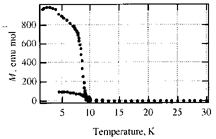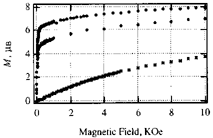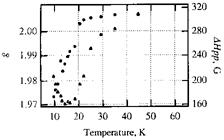 1
1Katsuya INOUE and Hiizu IWAMURA (Kyushu Univ.)
[Adv. Matter. 8, 73 (1996)]
Black powders of 12·[Mn(II)(hfac)2]3 were obtained by mixing the entitled tris(nitroxide) (1) and bis(hexafluoroacetylacetonato)manganese(II) {Mn(II)·(hfac)2} in a mixed solvent acetone/n-heptane. As the temperature was lowered, the observed molar susceptibility times temperature increased, gave a maximum at 10 K. The magnetization versus T plots for the complex measured at a magnetic field of 5 Oe showed a sharp rise at TC = 9.5 K. The saturation magnetization value was 9 (mu)B at 20000 Oe and 5 K in good agreement with a model in which a perfect 2-D ferrimagnetic sheet with heterospin ferromagnetic - antiferromagnetic network stack ferromagnetically across the layer.
 1
1

Figure 1. Magnetization vs. T plots for the complex 12·[Mn(II)(hfac)2]3 measured in a field of 5 Oe and spontaneous magnetization.

Figure 2. Field dependence of the magnetization of 12·[Mn(II)(hfac)2]3 measured at 1.8 K (solid circle), 5.0 K (diamond), and 15.0 K (X).

Figure 3. The temperature dependence of g (circle) and (DELTA)Hpp (triangle) values for 12·[Mn(II)(hfac)2]3.